Fall 2022
Northern Queensland.
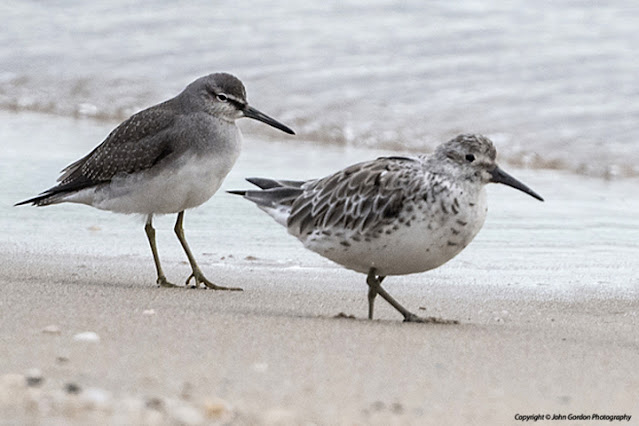 |
| Grey-tailed Tatler and Great Knot |
Eight days in New South Wales just flew by. The second portion of our trip was a three hour 2420 km flight to Cairns, Northern Queensland. The warmth and humidity was in stark contrast to what we had experienced in New South Wales. We had planned two days rest in Cairns before picking up our next camper van. First stop after checking into our hotel was the Esplanade, a shore birding hotspot and stop-off for guided tours. Unfortunately it was high tide so no new birds were seen except for the Welcome Swallows nesting under the boardwalk.
 |
| Great Knot and Red-necked Stint. |
I thanked the dog owner for her lack of consideration for which I duly received an Aussie finger. That was the end of the shorebirds until the next tide. The sky was heavily overcast and the morning light dismal but a few birds were stirring in the palm trees that lined the Esplanade. Yellow and Varied Honeyeaters and a distant view of a Superb Fruit-Dove rounded out the session. The sun came out.
 |
| Varied Honeyeater. |
 |
| Superb Fruit-Dove. |
I headed for a coffee. A sliver of rocky foreshore provided glimpses of Pacific Reef Heron and Black-necked Stork. A White-breasted Woodswallow was hawking insects. The life list was growing as was my appetite.
 |
| Black-necked Stork. |
 |
| Bush Thick nee |
Soon it was time to leave Cairns but not before noticing a flock of House Sparrows picking bugs off the grill of a 4x4, a behavior. I hadn't seen them do anywhere else on my world travels, be it Churchill Manitoba or Kathmandu. It was time to leave the coast and take the steep and windy road to the cooler climes of the Atherton Tablelands.
Our first stop was Kuranda for local information. We spent a few hours at the Rainforest Nature Park checking out critters (mostly nocturnal) we might not see in our travels. Around the parking lot I picked-up a Silvereye, Barred Cuckoo-shrike, Channel-billed Cuckoo, Spotted Catbird and a Forest Kingfisher before heading to the Billabong Campground for the night.
 |
| Silvereye |
After a long day we settled into Billabong Campground for the evening. It was one of the few paid campsites we used but proved to be well worth it. Daybreak couldn't come soon enough. The birds were our alarm clock and at 5 a.m. I was awake, my other half still in dreamland.
The first lifer of the morning was a Victoria's Riflebird followed by an Olive-sided Sunbird, Leaden Flycatcher, Scarlet and Dusky Myzomela, Black-faced Monarch, Northern Fantail and a great selection of honeyeaters including Macleay's, White-throated, Brown, Cryptic and Brown-backed.
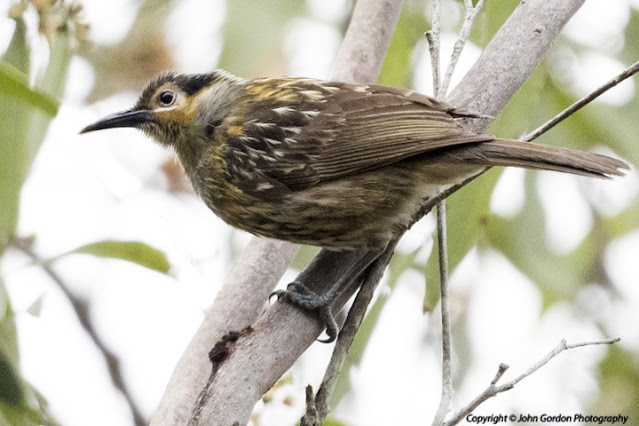 |
| Macleay's Honeyeater. |
What a morning and those were just a few of the birds noted! High above the campground on a rocky outcrop I watched a flock of Scaly-breasted Lorikeets feeding on termites. The sunrise quickly followed.
 |
| Scaly-breasted Lorikeets |
Soon it was time to leave the rainforest and head into the drier Savannah habitat of the Atherton Tablelands proper. Over the next two weeks we drove back to Brisbane passing through picturesque villages and towns, met some colourful characters and stayed at some wonderful campsites. I suggest downloading the WikiCamps which outlines all free and paid campsites on your route. We found the free campsites to have better birding as they were often in undeveloped areas while the paid campsites were often a little too groomed. On the flip side the latter had showers and were sometimes the only option to bird certain hotspots like Oreilly's Rainforest Retreat which I will be featured in the last of the Australia blogs.
 |
| Spotted Catbird |
 |
| Red-browed Finch |
The AthertonTablelands had it all. Big skies and red dirt farmland dotted with lakes and swamps, some of which were impassable due to flooding. Recently tilled fields provided ample food sources for the large flocks of Red-tailed Black Cockatoos and Sarus Cranes. Finches fed on the wild grasses that were lining the ditches.
 |
| Red-tailed Black Cockatoo |
Overhead Whistling, Black and Brahminy Kites rode thermals. Keeping one's eyes on the road was a challenge as the birds swept overhead. We always made a point of stopping for the night well before dusk so as not to encounter kangaroos and wallabies. Lizards sunning on the road were particularly vulnerable.
 |
| Brahminy Kite |
 |
| Dollarbird |
 |
| Comb-crested Jacana |
****
We headed south for the coast and Etty Bay where we hoped to spot a Southern Cassowary. On the way we met quite a number of Brits and Canadians, mostly young people who had made the leap across the pond. Australia seems to have it all, especially if you enjoy the outdoors.
On the first day, the Cassowary was a no show so we booked a second night and kept hoping. A large track of forest that borders the ocean has been set aside just for the giant birds. Loss of habitat is the main threat to the species, road kill and dogs another. There are no trails in the forest so the only hope is if a bird comes down to the beach to feed.
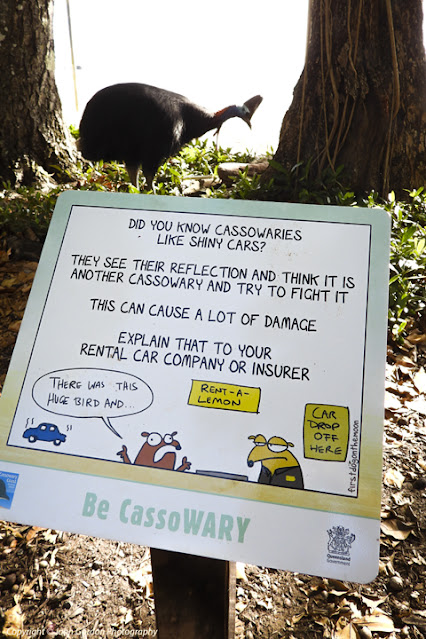 |
| There were plenty of warning signs. |
Finally on day two we were in luck. Cassowaries are big birds. The height is normally 1.5 to 1.8 m (4.9–5.9 ft); females average 58.5 kg (129 lb), while males average 29 to 34 kg (64–75 lb) and when one walked out of the forest and on to the beach everyone had the cameras and phones out to record the sight. I grabbed my camera but with a 500mm lens had trouble fitting the huge bird into the frame so I ended up using a point and shoot with a zoom lens.
A second bird appeared and wandered into the campground which is where Sandee, my wife, had a close encounter of sorts. Later she told me that while reading her book she felt a puff of wind on her neck, a burp she thought, turning around she was more than surprised to find herself face to face with a Cassowary. Eventually the bird moved on.
 |
| A Southern Cassowary searches for fruits washed onto the beach. |
Etty Bay to Gumlu
Dairy Entry;
It's so hot and humid, the ocean was warm, no crocs or stinging jellyfish to contend with but I stupidly got sunburnt. After Etty Bay we drove toward Townsville. stayed in another free campsite, heard the most unusual and loud bird calls, beautiful sunset, rained at night. Some new birds but too tired to check the bird guide. Must get a decent nights sleep for a long drive tomorrow. The side winds off the ocean could easily send the van off course, the sugar cane trucks barrelling past us to keep us on our toes. Sandee doesn't want to drive in case she hits a roo. She becomes designated bird spotter.
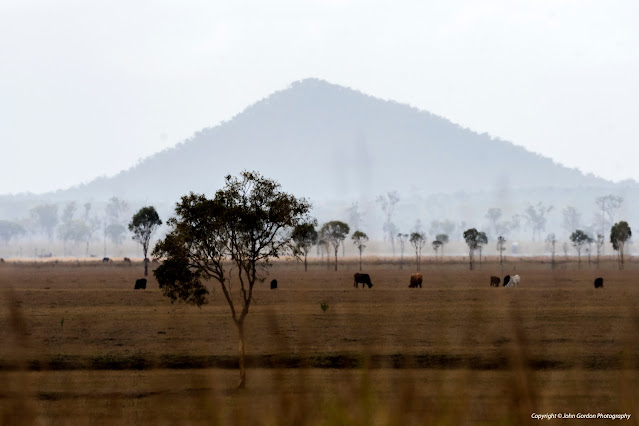 |
| Countryside around Gumlu. Cattle, sugarcane and vegetables were the main crops. |
At the end of the day we stop in Gumlu, pop 181. We are the only campers. The post office acts as liquor store, bar and restaurant and everything else for the surrounding farming community. Farms hands bring in watermelons and squash and leaves them for anyone who wants them. They leave with 48 packs of beer, thirsty work farming. We ate a delicious meal outdoors, swapped stories with locals and drank beer. Overhead a flock of Cockatiels passed close enough for a positive ID. They are known locally as Quarrybirds. Suddenly five Whistling Kites appear out of nowhere feasting on a passing swarm of grasshoppers.
 |
| The Goanna is one of twenty-five Australian monitor lizard species. Some like this one above can reach 2.5 m or eight feet. |
A refreshing wind picks up as the sun sets on another day in paradise. I have to pinch myself and wonder how fortunate we are to see all this. Next day in one rest area a Grey Kangaroo and its joey hop off into the undergrowth, I spooked them while stalking a bird.
Grey Kangaroo and her joey.
The trip down to Hervey Bay, pronounced Harvey was a long, hundred mile plus drive. "I used to think ten miles was a long way when I grew up in the UK." We met Andrew and Cliff, who we met through the Ap Birding Pals, who were to be our hosts. I had phoned them on an off chance. I'm glad I did. A couple, they told us about their aboriginal heritage and mixed blood. Eugenics Australia style, they called it. There are always two sides to a story and we were happy to listen. Australia and Canada have much in common when it come to the treatment of Aboriginal and First Nations. We both learnt a lot and have continue to read up on the history of Australia.
 |
| Sulphur-crested Cockatoo comes to the feeder. |
Years ago they two bought a property and are letting it return to nature. Their house is surrounded by a small forest. There were feeders everywhere, a resident python hangs around waiting for a hapless parrot or rodent. Eventually as they age, the house will be entwined and return to the earth. It was an honour to spent a brief time with such hospitable people.
 |
| Pale-headed Rosella. |
After a quick 'cuppa' we headed for Hervey Bay, our first stop was a nondescript field behind a mall. Amongst the few trees and sparse shrubs was a nesting Grey Butcherbird, although commorn, it was a lifer. The beach was a rare opportunity to see some shorebirds. First up a Striated Heron, Pied Cormorant, Lesser Crested and Common Tern, Ruddy Turnstone, Red-capped, Greater and Lesser Sand-Plovers and a Brown Booby. Across the road from the beach was a Flying Fox colony.
 |
| Black Flying Fox or Black Fruit Bat among the largest bats in the world. They eat fruits, pollen and nectar. |
 |
| Common Grass Yellow. |
Finally, when I saw the address we were going to stay at in Brisbane I knew our trip was meant to be. The address was #1 Birdie Place with cross street of Albatross Crescent, perfect but being bird brained it never occurred to me that we were staying next to a golf course. Finally it twigged, those are golf terms and have nothing to do with birds at all!
 |
| A pair of Galah |

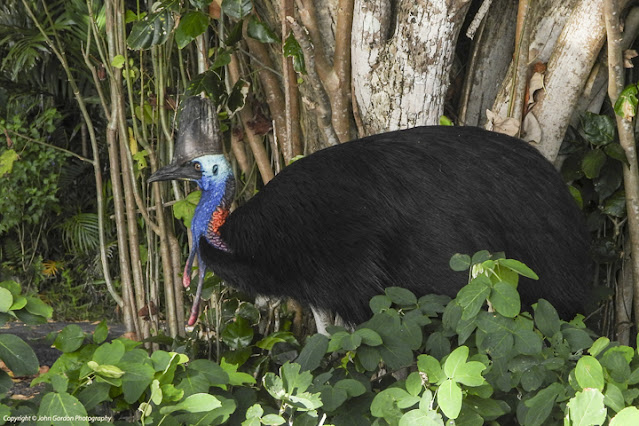



No comments:
Post a Comment